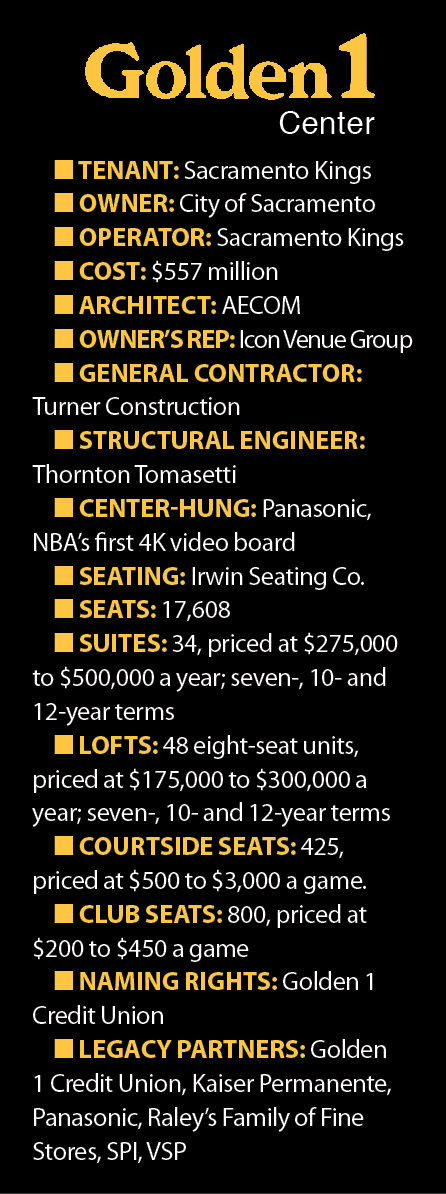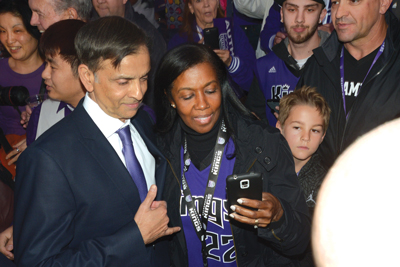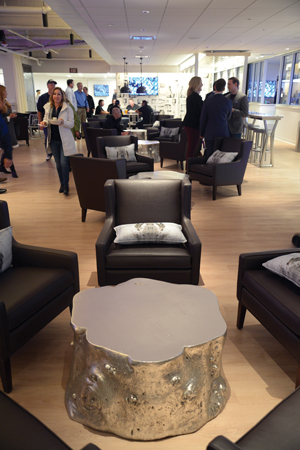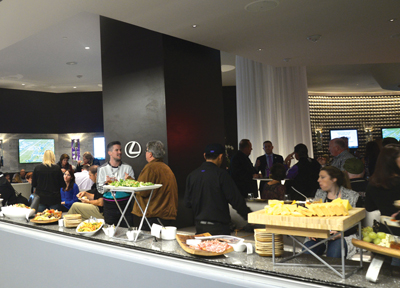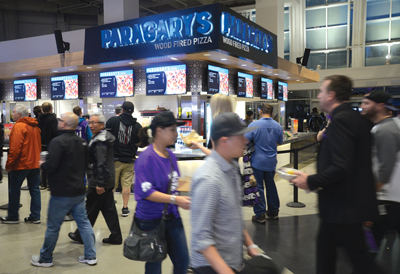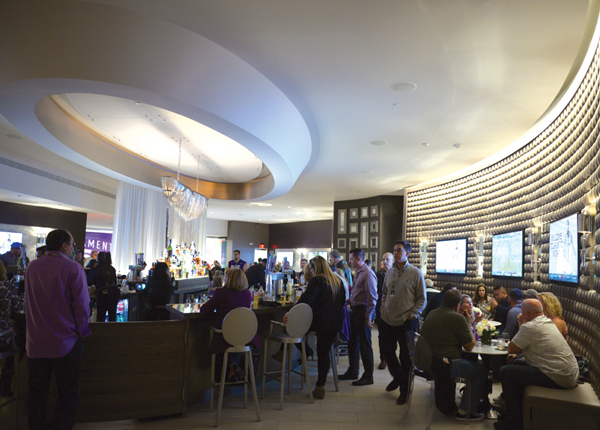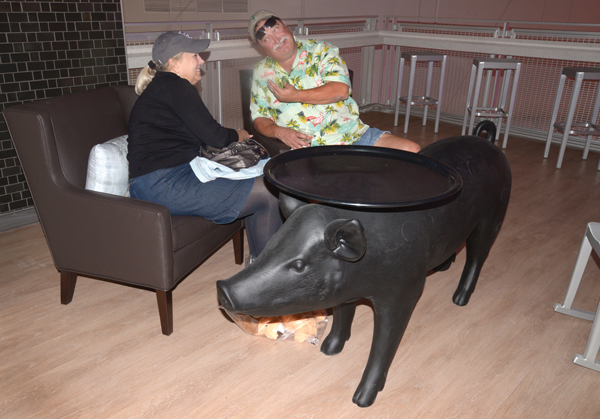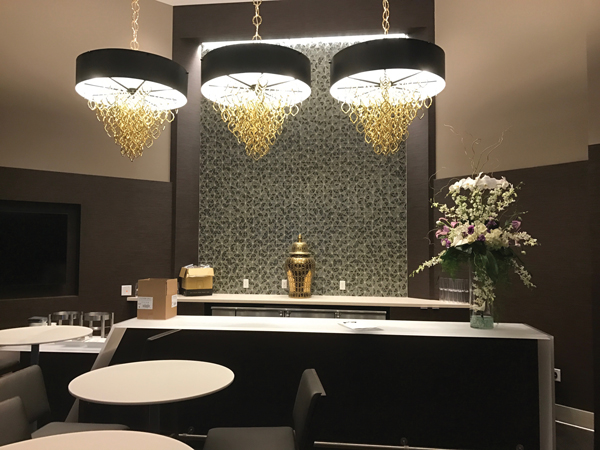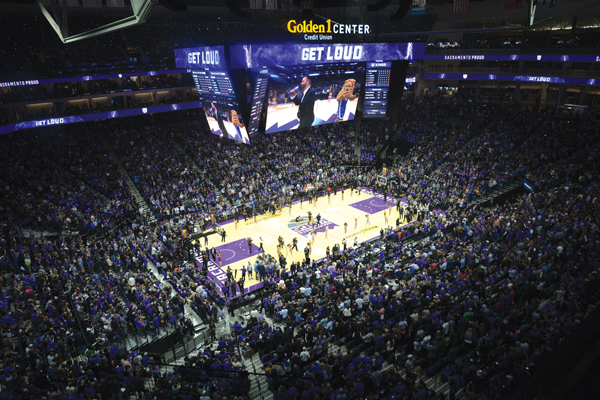 |
The lower bowl at Golden 1 Center has the most seats in the NBA.
Photo by: DENNIS MCCOY / SACRAMENTO BUSINESS JOURNAL
|
Shortly before tipoff at Golden 1 Center, the Sierra Nevada Draught House, a standing-room space in the upper deck overlooking the court, was bustling with beer drinkers.
One Sacramento Kings fan stood out in the younger crowd upstairs, with a crown on his head and a cowbell, the team boosters’ ubiquitous calling card, draped around his neck. His get-up (and drink of choice) for the Kings’ first regular-season game at their new arena represented the “uniquely Sacramento” design theme for the $557 million facility.
The building is tech heavy, in part a reflection of Kings owner Vivek Ranadivé’s background (
see related story). At the same time, though, it screams Sacramento, a largely agricultural community that’s also California’s state capital.
Sierra Nevada, a family-owned brewery at the forefront of the craft beer movement, certainly fits the homegrown mantra. Its headquarters sits 90 miles north of Sacramento, and the Draught House has become a popular hangout since the arena opened in early October.
“It’s a perfect marriage, and I’m thrilled they are getting the traffic up there that we would want them to,” Kings President Chris Granger said. “It celebrates local and craft, and it’s such a cool vantage point. It’s become one of the best bars in Sacramento.”
The Draught House bar contains reclaimed wood from Sierra Nevada’s brewery in Mills River, N.C., which opened in 2014 as an LEED Platinum facility, the highest level of sustainability. Golden 1 Center earned the same achievement, a first in the big leagues.
All told, 90 percent of the food and drink served by Legends, the arena’s concessionaire, comes from local sources within 150 miles of Sacramento. As a result, Golden 1 Center has one of the strongest farm-to-fork programs among big league arenas and stadiums.
Sustainability was one of four goals the team established for arena development, Ranadivé said. In addition, it was important to construct an iconic building, as well as a fan-friendly facility and a “future-proof” venue that uses forward-looking technology.
“We were trying to spend money where we think we get the most bang for the buck,” Granger said. “The signature areas that help define our building [such as] the indoor/outdoor design, the technology platform and a green infrastructure that will efficiently serve our building for decades to come.”
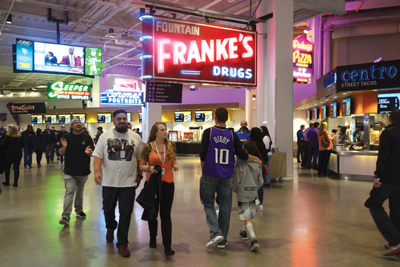 |
Signs from Sacramento’s past, rescued from a basement, line the concourse. BELOW: A fan takes a selfie with owner Vivek Ranadivé. AT BOTTOM: The Croft lounge offers subtle local touches.
Photos by: DENNIS MCCOY / SACRAMENTO BUSINESS JOURNAL
|
At the main entrance on the arena’s northwest side, five towering glass doors (
see related story) that fold up garage-style — together standing 50 feet tall and 150 feet wide — create the NBA’s first indoor-outdoor venue.
“California is all about indoor-outdoor living,” Ranadivé said. “The architects presented many different ideas and when they showed me that idea, that was it. That was something that became the exclamation point for the arena.”
Walking through those doors, fans see Sacramento restaurateurs given prime placement in the concessions
operation. The hometown theme continues with the half-dozen classic neon signs hanging overhead on the main concourse from businesses such as Shakey’s Pizza and Tower Records, both of which were founded in Sacramento.
The signs, representing 75 years of downtown Sacramento history, were collecting dust in the basement of the Center for Sacramento History before David Bradford Lee, part of the
Kings’ in-house design group, came up with the idea to restore them for display in the arena. It’s become one of the most photographed areas of the building as arena patrons reconnect with the signs and the memories they inspire, Granger said.
On the premium levels in the suite hallways, daily newspaper The Sacramento Bee sponsors displays of photos taken by its staffers over the years.
There are subtle touches, too, such as the piggyback cocktail tables, in Croft, a lounge named after a term describing a small patch of farmland. The tables and lounge title both reflect the strong agricultural ties in a city that’s home to the California State Fair.
The furniture design, fire pits in the club lounges and private wine-tasting rooms tucked into the premium levels are examples of the collaboration between the team and arena architect AECOM in the facility’s development, said Mike Wekesser, AECOM’s sports design director.
Golden 1 Center has a clean look, mostly free of advertising, and even the premium levels have polished concrete floors and white walls. A color palette of California earth tones, with lots of grays, browns and greens, is consistent across all levels.
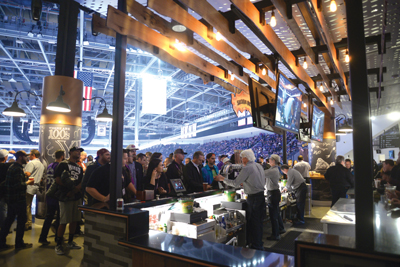 |
The Sierra Nevada Draught House packs in fans on the upper level. BELOW: Lining up for eats at the Lexus Lounge. BOTTOM: Paragary’s is among the local restaurants with an arena presence.
Photos by: DENNIS MCCOY / SACRAMENTO BUSINESS JOURNAL
|
Elsewhere, there are dashes of luxury inside the four event-level clubs. The Lexus Lounge faces the Kings’ locker room and the pathway that players take to reach the court. A cowbell carrying the Kings’ brand hangs overhead for the players to ring as they run onto the hardwood.
It’s the arena’s version of the famous “Play Like a Champion Today” sign outside the home locker room at Notre Dame Stadium, Granger said.
The Boardroom, meanwhile, is reserved for team ownership, the arena’s naming-rights partner and
first-row courtside seat holders. A separate room within the Boardroom for intimate gatherings is Sacramento’s version of the Chairman’s Room at Barclays Center, home of the Brooklyn Nets.
That exclusivity aside, the arena largely celebrates a city that’s allabout families and community, Ranadivé said.
“In the old days, people gathered around communal fireplaces,” he
said. “Later on, it was the market square or the cathedral. This is the cathedral of the future.”



